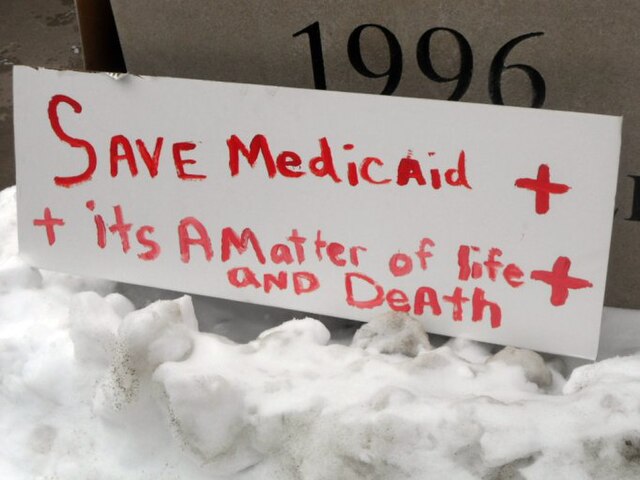Keep Our NHS Public continues to fight vigorously on a number of different fronts as Covid, austerity and government abandoning all pretence of following the science wreak havoc. Meanwhile, the NHS is further threatened by proposals in the Health and Care Bill. With Health Secretary Sajid Javid declaring that Britain is the freest country in Europe, and the ending of all Plan B restrictions, it might appear that the pandemic is all but over.
The requirement to isolate for those with infection is due to lapse on February 24th. Statistics, however, tell a different story and this is clearly a decision based on political rather than scientific considerations. The Omicron variant has swept the board, and while less likely to cause severe disease, it has a very high rate of transmission.
In early February, there were around 160,000 new symptomatic cases each day, and 14,600 infected hospital inpatients. Daily deaths from Covid have regularly been over 250 (1 every 6 minutes!) with a peak of 276 on the 17th January, the highest daily total since 23rd February 2021. The Office for National Statistics has recorded over 178,000 Covid-related deaths since the start of the pandemic.
To many, the possibility of a new and more lethal variant remains a huge threat, augmented by high levels of circulating infection – a strong argument for ensuring vaccination is rolled out across the world. Recently, 320 academics have pressed the government for support to Low- and Middle-Income Countries to manufacture Covid vaccines, tests and treatments.
In addition, much more must be done to suppress community transmission and reduce the likelihood of a new serious mutation. Low rates of infection would then permit public health measures such as ‘test, trace, isolate, support’ to control further spread of virus. The misleading narrative that we are learning to live (should this be ‘die’?) with Covid is contributing to what the Commons joint committees’ report correctly characterised as among the worst ever public health failures in our history.
One of the highest rates of death in proportion to population gives the lie to the much-parroted phrase that the prime minister got all the big calls right. Such delusional thinking means that the NHS is now on a ‘war footing’, with waiting lists massively increasing and many people being denied the care they need.
The Health and Care Bill
This Bill addresses none of the most pressing problems in the NHS. It has been described succinctly as: “an astonishing attempt to allow the Secretary of State, an enlarged NHS England as ‘rule-maker and regulator’, and new public-private ‘Integrated Care Boards’, to reduce services, limit expenditure, further degrade local accountability and entrench the market.” No wonder legislators are finding it difficult to explain to voters just what benefits patients might expect it to deliver. While this Bill should be rejected outright, parliamentary arithmetic suggests this won’t happen, and campaigners have been lobbying for amendments that could ameliorate some of the worst effects. However, there is no indication that any important revisions will be forthcoming.
The start of Integrated Care Systems (central to the Bill) has been delayed from April until July in recognition that further debate is now unlikely to be completed in time for Royal Assent at the end of March. The committee stage in the Lords is almost over following which the report stage gives a further opportunity for the Lords to discuss and make amendments. The Bill then returns. The Bill then returns to the Commons when key votes will take place on amendments proposed
With the 2012 Health and Social Care Bill, it was noted that many Lords had private interests in insurance companies, private health care and private equity groups, and were in danger of voting on behalf of private and personal interests that stood to gain from the Bill rather than in the public interest. It is likely that situation is not much changed. For example, Lord Hunt of Kings Heath has proposed that 5% of budgets must be ring-fenced for digital transformation. The Parliamentary Register of Interests shows him as the paid Chair of the Advisory Board for Octopus TenX Health, a health technology investment company.
‘SOS NHS’: building a movement so massive, loud and strong that the government simply cannot ignore
The recent People’s Covid Inquiry organised by Keep Our NHS Public highlighted the effects of austerity in undermining the NHS, weakening its ability to respond to the pandemic. The final report concluded that there may be the basis for criminal proceedings related to charges of misconduct in public office; the Metropolitan police have been asked to investigate. The Inquiry raised the question of what kind of NHS and care system we need in the future.
SOS NHS is an ambitious new campaign supported by around 40 key organisations. It represents a diverse range of people, united in their desire to defend the NHS against neglect, underfunding and privatisation. The central demands are for an immediate £20 billion in extra spending as a down payment to start rebuilding a fully functioning public health and care system; investment in a publicly owned NHS and guarantee of free healthcare for future generations; proper pay for staff.
The recently announced recovery plan falls far short of what is needed. It lacks sufficient investment and fails to address workforce issues without which promised improvements simply can’t happen. Mental health, GP services and urgent and emergency care are not covered, all of which are in dire trouble. The 5,000 beds closed during the pandemic are not being reopened and more cash is being directed to private sector providers.
SOS NHS has called for a national day of action on 26th of February with events being held in many towns and cities. One lesson to be learned from pandemic spending is that money can always be found if there is political will.
This article was written for Chartist no 315, March/April 2022 edition. With thanks to Mike Davis for permission to reproduce.




